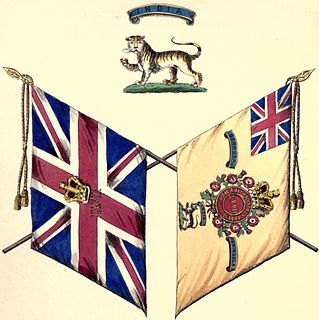
The 50th Regiment of Foot was an infantry regiment of the British Army, raised in 1755. Under the Childers Reforms it amalgamated with the 97th Regiment of Foot to form the Queen's Own Royal West Kent Regiment in 1881.
The 77th Regiment of Foot was a Highland Scots Regiment raised in 1757. The 77th Regiment was one of the first three Highland Regiments to fight in North America. During the Seven Years' War, the regiment lost 110 soldiers and 259 were wounded.
The 78th Regiment, (Highland) Regiment of Foot also known as the 78th Fraser Highlanders was a British infantry regiment of the line raised in Scotland in 1757, to fight in the Seven Years' War. The 78th Regiment was one of the first three Highland Regiments to fight in North America.

The 55th Regiment of Foot was a British Army infantry regiment, raised in 1755. After 1782 it had a county designation added, becoming known as the 55th (Westmorland) Regiment of Foot. Under the Childers Reforms it amalgamated with the 34th (Cumberland) Regiment of Foot to form the Border Regiment in 1881.
The 38th Regiment of Foot was an infantry regiment of the British Army, raised in 1705. Under the Childers Reforms it amalgamated with the 80th Regiment of Foot to form the South Staffordshire Regiment in 1881.
The 91st Regiment of Foot was a Line Regiment of the British Army, raised in 1794. Under the Childers Reforms it amalgamated with the 93rd Regiment of Foot to form the Argyll and Sutherland Highlanders in 1881.

The 67th Regiment of Foot was a line infantry regiment of the British Army, raised in 1756. Under the Childers Reforms it amalgamated with the 37th Regiment of Foot to form the Hampshire Regiment in 1881.
Three regiments of the British Army have been numbered the 87th Regiment of Foot:
The 100th Regiment of Foot, also known as Campbell's Highlanders, was an infantry regiment of the British Army, formed in 1760 and disbanded in 1763.
The 88th Regiment of Foot , or Campbell's Highlanders, was a Scottish infantry regiment in the British Army, formed in 1760 and disbanded in 1763.
The 114th Regiment of Foot was an infantry regiment of the British Army from 1761 to 1763.It was raised in October 1761, by Sir Allan MacLean of Torloisk. He was commissioned lieutenant in the 60th Foot Royal Americans at the beginning of the Seven Years' War and was severely wounded at Ticonderoga in 1758. He was then given one of the four NY Independent Companies until he returned to Scotland where he raised the 114th Maclean's Highlanders, or the Royal Highland Volunteers, as their Major Commandant. The regiment was disbanded in 1763.
The 101st Regiment of Foot, or Johnston's Highlanders, was an infantry regiment of the British Army, formed in 1760 and disbanded in 1763.The regiment was raised in 1760 by the regimentation of independent companies of infantry raised in Argyll and Ross-shire; in 1761 it was moved into England, and its other ranks drafted to the 87th and 88th Foot.
The 109th (Aberdeenshire) Regiment of Foot was an infantry regiment of the British Army from 1794 to 1795. Raised by Alexander Leith Hay for service in the French Revolutionary Wars the regiment was briefly deployed in Jersey before it was disbanded in England and its men sent to reinforce the 53rd (Shropshire) Regiment of Foot. The disbandment was controversial as Leith-Hay believed it contravened an assurance given to him in his original letter of service to raise the regiment.
David Graeme was a British soldier, diplomat and courtier, responsible for carrying George III’s proposal of marriage to Charlotte of Mecklenburg-Strelitz.
The 105th Regiment of Foot was a short-lived British line infantry regiment. It was raised in Perthshire by Major-General David Graeme as a two-battalion regiment on 15 October 1760 by converting independent companies. It was named after Charlotte of Mecklenburg-Strelitz, who had been selected as the wife for the future George III of England. The regiment served in Ireland and was disbanded in 1763.
The 76th Regiment of Foot , sometimes referred to as 'MacDonnell's Highlanders' after its colonel, John MacDonnell of Lochgarry, was a Scottish Light Infantry regiment raised in the west of Scotland and western isles of Scotland in 1777.
The 89th (Highland) Regiment of Foot or Morris's Highlanders was an infantry regiment in the British Army from 1759 to 1765.
The 90th Regiment of Foot was a short-lived infantry regiment in the British Army which was raised in Ireland as a light infantry corps in 1759, during the Seven Years' War with France.
The 85th Regiment of Foot was a short-lived British Army regiment during the Seven Years' War. It was recruited at Shrewsbury in 1759 as the first full regiment of light infantry in the British Army and originally intended for service in the North American campaign.





